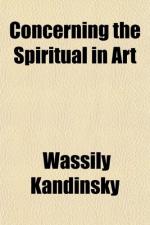So it is not surprising that he stands in close relation
to the young Russian composers, the chief of whom
is Scriabin. The experience of the hearer is
frequently the same during the performance of the works
of these two musicians. He is often snatched quite
suddenly from a series of modern discords into the
charm of more or less conventional beauty. He
feels himself often insulted, tossed about like a
tennis ball over the net between the two parties of
the outer and the inner beauty. To those who are
not accustomed to it the inner beauty appears as ugliness
because humanity in general inclines to the outer
and knows nothing of the inner. Almost alone
in severing himself from conventional beauty is the
Austrian composer, Arnold Schonberg. He says in
his Harmonielehre: “Every combination of
notes, every advance is possible, but I am beginning
to feel that there are also definite rules and conditions
which incline me to the use of this or that dissonance.”
[Footnote: “Die Musik,” p. 104, from
the Harmonielehre (Verlag der Universal Edition).]
This means that Schonberg realizes that the greatest
freedom of all, the freedom of an unfettered art,
can never be absolute. Every age achieves a certain
measure of this freedom, but beyond the boundaries
of its freedom the mightiest genius can never go.
But the measure of freedom of each age must be constantly
enlarged. Schonberg is endeavouring to make complete
use of his freedom and has already discovered gold
mines of new beauty in his search for spiritual harmony.
His music leads us into a realm where musical experience
is a matter not of the ear but of the soul alone—and
from this point begins the music of the future.
A parallel course has been followed by the Impressionist
movement in painting. It is seen in its dogmatic
and most naturalistic form in so-called Neo-Impressionism.
The theory of this is to put on the canvas the whole
glitter and brilliance of nature, and not only an
isolated aspect of her.
It is interesting to notice three practically contemporary
and totally different groups in painting. They
are (1) Rossetti and his pupil Burne-Jones, with their
followers; (2) Bocklin and his school; (3) Segantini,
with his unworthy following of photographic artists.
I have chosen these three groups to illustrate the
search for the abstract in art. Rossetti sought
to revive the non-materialism of the pre-Raphaelites.
Bocklin busied himself with the mythological scenes,
but was in contrast to Rossetti in that he gave strongly
material form to his legendary figures. Segantini,
outwardly the most material of the three, selected
the most ordinary objects (hills, stones, cattle, etc.)
often painting them with the minutest realism, but
he never failed to create a spiritual as well as a
material value, so that really he is the most non-material
of the trio.
These men sought for the “inner” by way
of the “outer.”
By another road, and one more purely artistic, the
great seeker after a new sense of form approached
the same problem. Cezanne made a living thing
out of a teacup, or rather in a teacup he realized
the existence of something alive. He raised still
life to such a point that it ceased to be inanimate.




